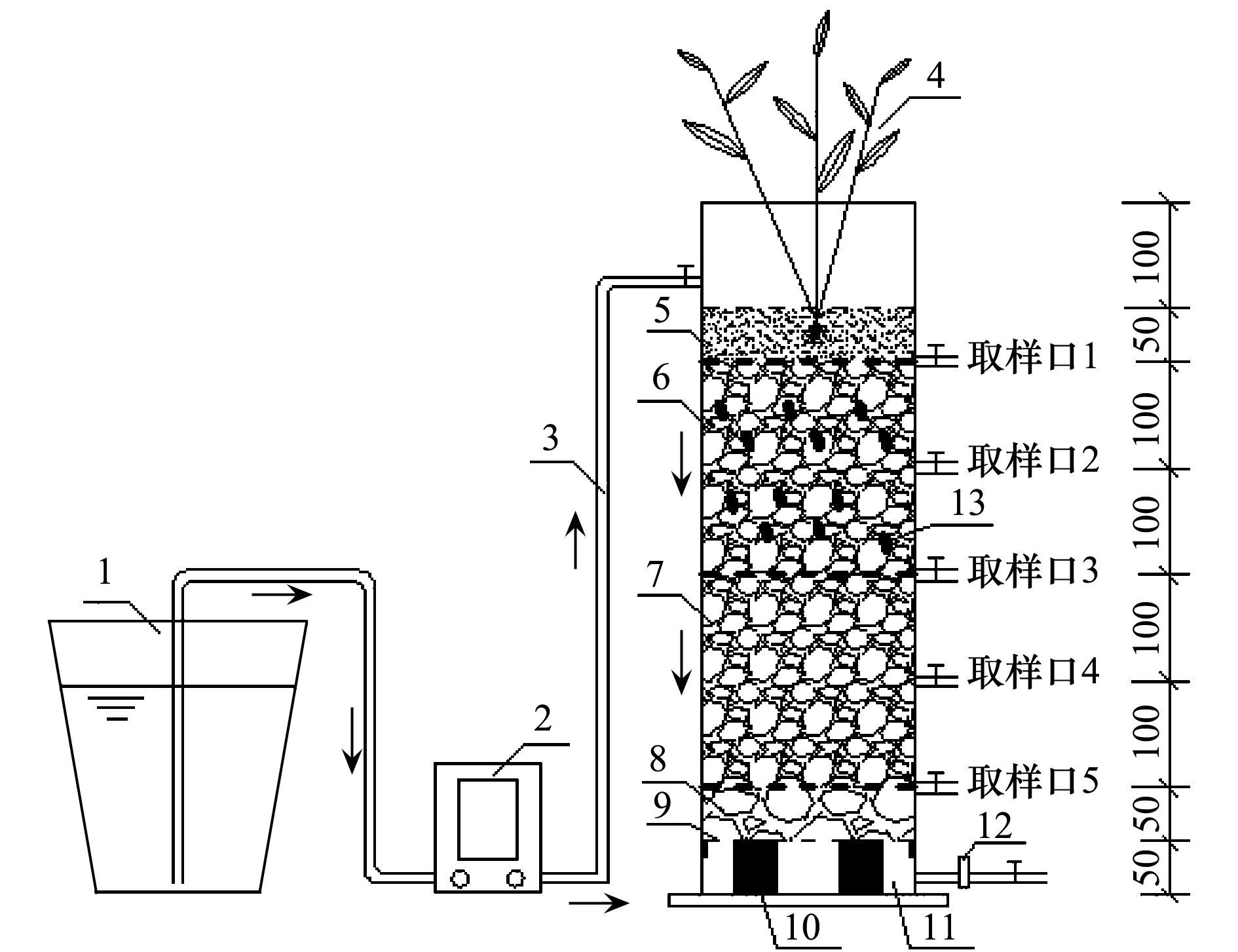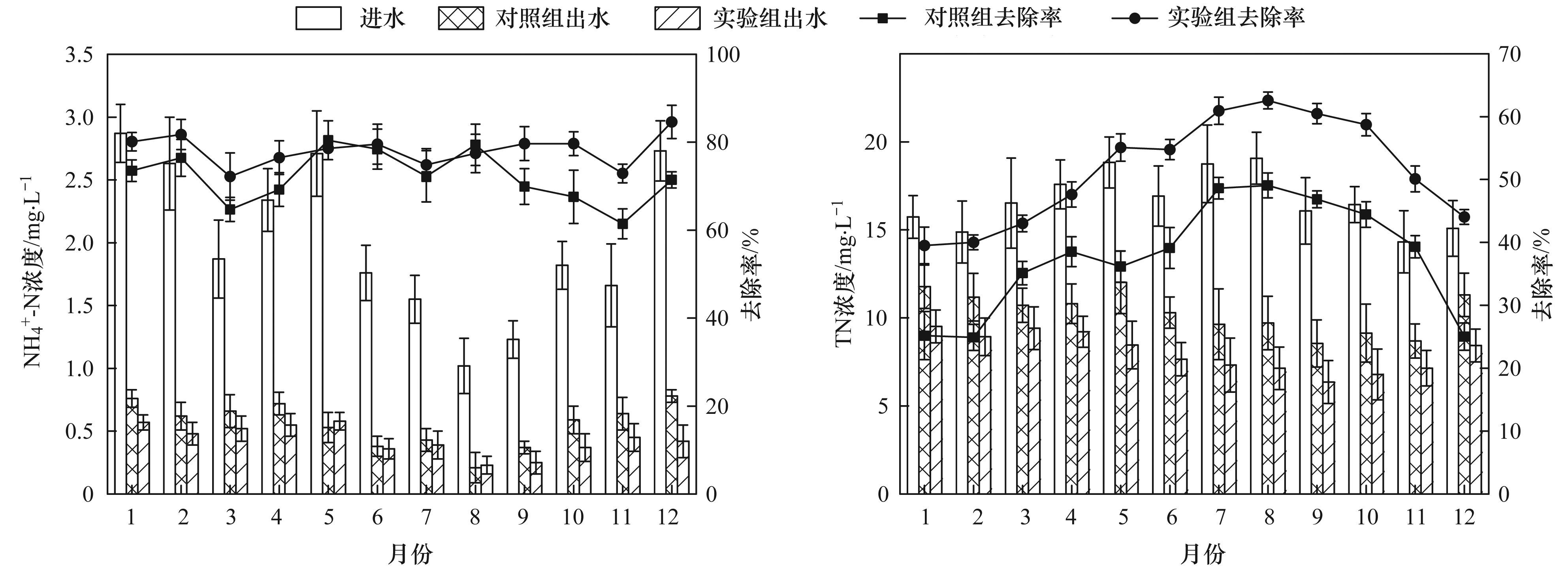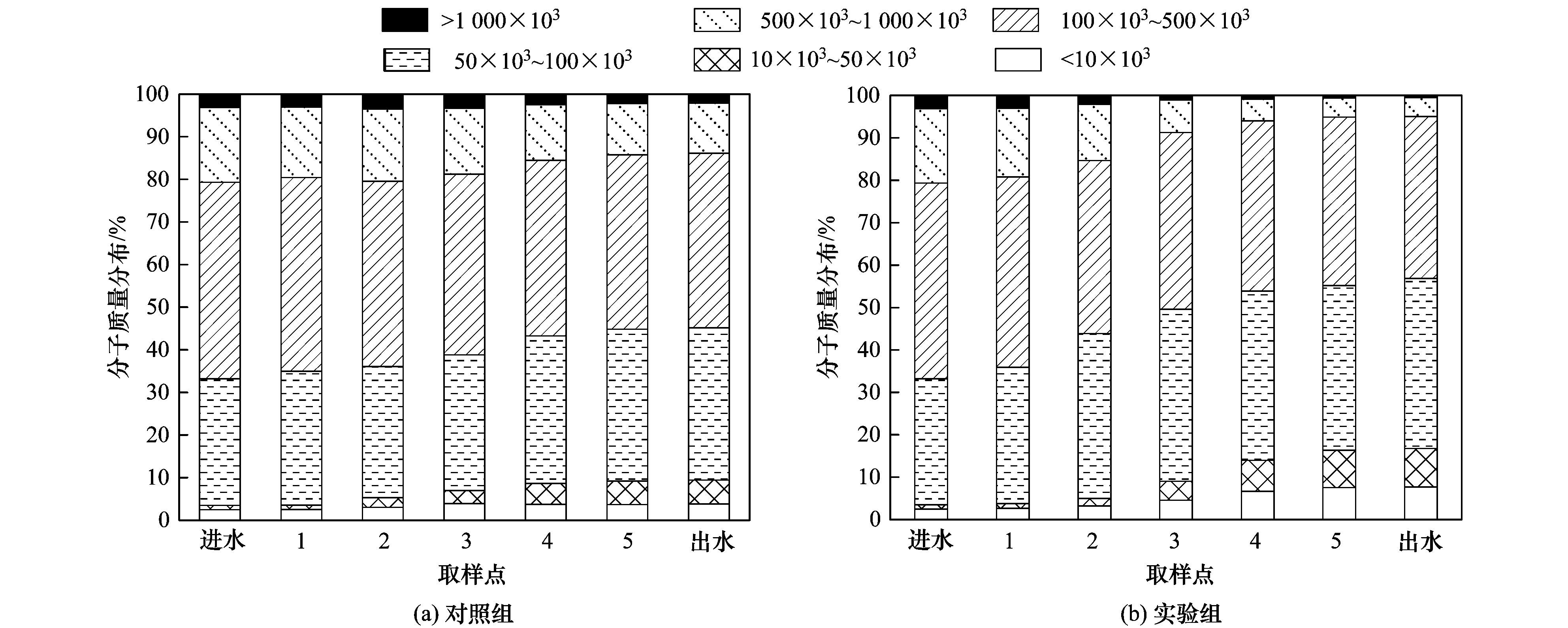2. 江苏省水资源服务中心, 南京 210029
2. Water Resources Service Center of Jiangsu Province, Nanjing 210029, China
目前, 我国大多数污水处理厂以二级处理为主, 即使污水厂尾水达到《城镇污水处理厂污染物排放标准》(GB 18918-2002) 一级A/B标准, 仍属于劣Ⅴ类水, 对于受纳水体而言还是重要的污染源[1].同时考虑到国际公认的水体发生富营养化的临界值[TN 0.2 mg·L-1, TP 0.2 mg·L-1][2], 二级出水依旧是造成受纳水体富营养化的主要原因之一[3].污水处理厂提标改造, 尾水进行深度处理, 是未来的发展趋势, 北京市、天津市已先后发布了更为严格的城镇污水处理厂污染物排放标准.
人工湿地是近年来发展起来的一种新型生态处理技术, 具有污染物去除效果稳定、投资省、运行成本低等显著优点, 是削减二级出水中氮磷、有机物等污染物的有效工艺之一[4~7], 为污水处理厂尾水的深度处理开辟了一条新途径.然而, 经过污水厂生化处理单元处理后, 尾水的碳源低、可生化性差(BOD5/COD为0.2~0.35, BOD5/TN约为1).尾水中有机碳源主要有富里酸、腐殖酸以及亲水性有机酸、核酸、氨基酸和表面活性剂等有机物[8], 难以被微生物降解、利用.同时, 硝酸盐氮是尾水中氮素的主要成分, 占TN的80%左右[9, 10].反硝化脱氮是人工湿地脱氮的主要方式, 尾水中可利用碳源不足限制了反硝化作用的进行, 影响湿地系统的脱氮效率[11~13].且冬季低温污染物去除效率低[14~16], 这也是限制人工湿地进一步推广应用的重要原因之一.
铁炭内电解法作为目前国内外研究较为成熟的电化学工艺, 已经在制药废水、印染废水、焦化废水等难降解废水的处理上得到了广泛应用.铁炭内电解与其他生化处理工艺相结合, 可以改善废水性质、提高废水可生化性、提高废水的处理效果[17].为此, 本研究构建新型铁炭内电解强化脱氮人工湿地(vertical flow constructed wetland associated with iron-carbon internal electrolysis, ICIE-VFCW), 通过在湿地基质中掺杂铁炭, 形成铁炭内电解与人工湿地耦合工艺, 利用铁炭内电解改善尾水可生化性, 为湿地微生物提供更多可利用碳源以强化湿地对氮素等污染物的去除, 并采用紫外-可见光光谱(UV-VIS)、凝胶过滤色谱(GFC)等深入分析铁炭内电解人工湿地的强化脱氮机制.本研究通过开发一种高效脱氮的人工湿地处理工艺, 以期为人工湿地的进一步推广应用提供技术支持.
1 材料与方法 1.1 人工湿地系统的构建垂直流人工湿地能够形成良好的好氧/缺氧环境, 有利于尾水的深度脱氮, 因此选择垂直潜流湿地作为实验装置[18].实验采用自行设计的下向垂直流人工湿地装置, 共2套(分别为对照组和实验组), 材料选用有机玻璃, 装置采用圆柱体, 尺寸为Φ×H=20 cm×65 cm, 以粗砂和天然砾石作为人工湿地主要基质, 种植芦苇作为湿地植物.装置底部设集水区, 通过穿孔有机玻璃板集水, 集水区高5 cm.为更加真实地模拟人工湿地, 装置四周采用遮光布包裹.人工湿地构造如表 1所示.为方便取样分析, 沿程设置5个取样口, 分别采集粗砂层、第一砾石基质层中部、第一砾石基质层、第二砾石基质层中部、第二砾石基质层的出水.人工湿地装置如图 1所示.污水经蠕动泵打入湿地, 通过底部的出水口、流量计控制出水, 并维持湿地水位恒定, 湿地孔隙率为35%, 设计水力停留时间为2 d.实验装置于2015年6月构建, 经近半个月后, 系统生物膜生长成熟, 出水稳定.
|
|
表 1 垂直流人工湿地构造1) Table 1 Structure of vertical flow constructed wetland |

|
1.进水桶; 2.蠕动泵; 3.进水管; 4.湿地植物; 5.粗砂层; 6.第一砾石基质层; 7.第二砾石基质层; 8.砾石承托层; 9.穿孔集水板; 10.底部支撑柱; 11.出水区; 12.转子流量计; 13.铁炭颗粒 图 1 垂直流人工湿地装置及取样点分布 Fig. 1 Vertical flow constructed wetland system and sampling locations |
实验前通过调研污水厂尾水以确定尾水的水质特征, 采用实验室自配水模拟污水厂尾水, 具体成分如表 2所示.实验期间(2015年7月~2016年6月)进水主要污染物平均浓度为:COD 53.16 mg·L-1、BOD5 6.73 mg·L-1、TN 16.68 mg·L-1、NH4+-N 2.02 mg·L-1、NO3--N 12.58 mg·L-1、TP 0.23 mg·L-1.
|
|
表 2 模拟污水厂尾水的水质 Table 2 Water quality of the simulated tail water of wastewater treatment plants |
经过1个月的稳定运行后, 采集进出水及沿程各取样口水样, 每月4次, 采样时间为上午09:00~11:00, 并于当日送至实验室进行水质分析.常规水质指标分析方法参考文献[19].沿程水样吸光度采用紫外-可见光光谱仪(普析通用T6新世纪)进行测定, 扫描波长范围为200~700 nm, 扫描步长为2 nm.以超纯水作基线, 去离子水为空白.各水样有机物相对分子质量分布采样GFC(凝胶过滤色谱, LC-10ADVP)测定, 测定前用0.45 μm微孔滤膜过滤, 进样量为20 μL.测定条件:TSK4000型色谱柱, 超纯水为流动相, 液体动力注入, 视差检测器型号RID-10A, 控制器型号SCL-10AVP, 柱温箱型号CTO-10SVP.
2 结果与讨论 2.1 垂直流人工湿地对尾水中有机物的去除两组人工湿地对尾水中COD的去除效果如图 2所示.从中可知, 实验组全年对COD的去除效果优于对照组.采用SPSS软件进行统计学分析, 两组湿地COD去除率存在显著性差异(P<0.05).湿地对COD的去除, 呈现出季节性变化, 随气温的升高而提高.实验组全年出水COD稳定在30 mg·L-1以下, 满足地表水Ⅳ类标准(30 mg·L-1), 而对照组在寒季(江苏地区12月到次年2月, 平均气温14.7℃)出水COD超过30 mg·L-1.对照组和实验组COD全年平均去除率分别为47.48%、57.64%, 暖季(江苏地区3~11月, 平均气温26.3℃)平均去除率分别为50.10%、59.91%, 寒季平均去除率分别为39.61%、50.83%, 实验组全年、暖季、寒季COD平均去除率分别高出对照组10.16%、9.81%、11.22%.可见, 基质掺杂铁炭能够提高湿地对COD的去除效果, 且冬季的提升效果更为明显.这可能主要是因为在污水浸渍条件下, 掺杂在湿地基质中的铁炭形成原电池, 阳极发生电极反应Fe-2eFe2+(E0=-0.44 V), 阴极发生电极反应O2+2H2O+4e4OH-(E0=+0.40 V)[20].铁炭内电解过程产生大量活性的[H]和Fe2+, 使尾水中的复杂有机物发生开环、断链等作用, 另外, 在活性Fe2+被O2氧化成Fe3+的过程中, 会产生具有强氧化性的·OH、O·, 破坏—CN和C=O键[21].原电池反应过程中产生的活性基团促进了难降解有机物分解为小分子, 强化了微生物对尾水中有机物的利用, 促进了湿地对COD的去除.

|
图 2 垂直流湿地进出水COD浓度及平均去除率 Fig. 2 Concentrations of COD in influent and effluent of vertical flow constructed wetland and average removal efficiencies |
两组湿地沿程溶解性有机物(DOC)及其光谱特征如表 3所示(10月12日测定结果).总体来看, DOC及各波长的吸光度沿程下降, 且对照组各采样点高于实验组.实验组采样点3的DOC明显升高, 可能是经过第一砾石基质层(铁炭层)后, 尾水中部分不溶性有机物转变成了可溶性有机物. a300/a400可表征污水腐殖度和芳香度, 该比值越大, 说明尾水中腐殖度和芳香度越小, 其难降解污染物含量越少[22, 23].两组湿地出水中a300/a400均大于进水, 表明经过人工湿地的处理, 尾水的腐殖度和芳香度均有所下降.湿地中腐殖度和芳香度高的物质难以被微生物降解, 实验组各采样点a300/a400大于对照组, 表明铁炭内电解可降低尾水的腐殖度和芳香度. a250/a365可作为水中溶解性有机物分子质量大小的评价指标, 该比值越大, 尾水中有机物平均分子质量越小[24]. 表 3中a250/a365总体上沿程降低, 表明污水中有机物分子质量逐渐下降, 且实验组a250/a365高于对照组, 说明实验组污水中大分子有机物向小分子转化更为彻底.对照组a250/a365沿程均匀下降, 而实验组经过铁炭层(取样点1~3) 后, a250/a365显著升高, 表明铁炭层是大分子有机物向小分子转化的主要单元.
|
|
表 3 湿地各采样点水样DOC质量浓度及光谱特征 Table 3 DOC and spectral characteristics of influent, effluent and sampling points along the path of vertical flow constructed wetland |
2.2 垂直流人工湿地对尾水中氮素的去除
两组湿地对尾水中NH4+-N、TN的去除效果如图 3所示.两组人工湿地对NH4+-N均有良好的去除效果, 出水浓度达到地表水IV类标准(1.5mg·L-1), 接近于Ⅱ类标准(0.5mg·L-1), 全年去除率相对稳定.

|
图 3 垂直流湿地进出水氨氮、TN浓度及平均去除率 Fig. 3 Concentrations of NH4+-N and TN in influent and effluent of vertical flow constructed wetland and average removal efficiencies |
两组湿地对TN的去除率表现出明显的季节性, 去除率随温度升高而升高.采用SPSS软件进行统计学分析表明, 两组湿地TN去除率存在显著性差异(P<0.05), 实验组全年TN平均去除率均高于对照组, 且出水浓度在10mg·L-1以下, 满足现阶段北京(2012年)、天津(2015年)更为严格的污水排放标准.对照组和实验组全年TN平均去除率分别为37.69%、51.41%, 暖季为41.91%、54.81%, 寒季为25.03%、41.20%, 实验组全年、暖季、寒季TN平均去除率分别高出对照组13.72%、12.90%、16.17%.
由此可见, 湿地基质掺杂铁炭有利于系统脱氮, 尤其是提高冬季低温的脱氮效率.这一方面是因为湿地基质掺杂的铁炭可改善尾水可生化性, 为后续微生物脱氮提供更多的可利用碳源, 从而提高脱氮效率.另一方面, Fe2+和Fe3+是微生物生命活动中重要的电子传递体系, 铁炭内电解过程中产生的Fe2+和Fe3+可以参与这种电子传递[25, 26], 从而加速细胞中的电子传递效率, 提高微生物活性, 改善系统脱氮效率, 特别是冬季低温脱氮效率.
两组人工湿地沿程氮素形态分布如图 4所示(10月12日测定结果).从中可知进出水及沿程污水中的氮素主要以NO3--N为主, 占TN的70%以上, 而NH4+-N在湿地系统中得到了较好的去除, 占TN比例始终在8%以下.实验组有机氮[Org-N, Org-N=TN-(NH4+-N)-(NO2--N)-(NO3--N)]基本沿程下降, 占TN比例由16.79%下降到6.48%, 而对照组Org-N占TN比例均在10%以上, 这主要是由于铁炭层中铁炭内电解可促进含氮难降解有机物的分解, 从而使Org-N占比显著下降.由于缺乏可利用碳源, 对照组还出现了NO2--N积累的现象.

|
图 4 垂直流湿地沿程氮形态分布 Fig. 4 Distribution of nitrogen forms along the path of vertical flow constructed wetland |
表 4为两组湿地进出水及各采样点溶解性有机物的Mr.从中可知, 湿地处理前后, 尾水中有机物的相对分子质量均有所下降, 对照组和实验组分别降低了25.82%、39.56%;且实验组经过铁炭层(取样点1~3) 后, Mr下降幅度较大, 分别为13.73%、24.15%, 这与DOC质量浓度及光谱特征变化相一致.
|
|
表 4 湿地进出水及各采样点水样溶解性有机物的相对分子质量×103 Table 4 Molecular weight values in influent, effluent and sampling points along the path of vertical flow constructed wetland ×103 |
两组人工湿地有机物沿程分子质量分布如图 5所示.湿地污水中有机物相对分子质量主要集中在50×103~500×103之间, 且有机物向小分子转变.经过湿地处理后, 对照组和实验组<10×103的有机物质量分数分别增加了1.31%和5.15%, 10×103~50×103的有机物质量分数分别增加了4.54%和8.11%.而500×103~1 000×103的有机物质量分数分别减少了4.80%和13.19%, >1 000×103的有机物质量分数分别减少了0.94%和2.56%.此外, 经过铁炭层(取样点1~3) 后, 500×103~1 000×103和>1 000×103的有机物质量分数显著下降, 分别下降了8.52%和1.97%.可见, 湿地基质掺杂铁炭能有效促进大分子有机物向小分子的转变[27].

|
图 5 垂直流湿地有机物相对分子质量分布 Fig. 5 Distribution of molecular weight of organics in influent, effluent and sampling points along the path of vertical flow constructed wetland |
(1) ICIE-VFCW可强化系统对污水厂尾水中COD的去除, 全年出水COD可稳定在30mg·L-1以下. ICIE-VFCW较不掺杂铁炭普通湿地全年、暖季、寒季COD平均去除率分别可提高10.16%、9.81%、11.22%.
(2) 无论湿地基质是否掺杂铁炭, 垂直流湿地对尾水中NH4+-N去除效果良好, 出水稳定在1.5mg·L-1以下, 接近0.5mg·L-1, 掺杂铁炭对NH4+-N去除影响不大.
(3) ICIE-VFCW可提高湿地的脱氮效率, 湿地出水TN可维持在10mg·L-1以下. ICIE-VFCW较不掺杂铁炭普通湿地全年、暖季、寒季TN平均去除率分别提高13.72%、12.90%、16.17%.
(4) ICIE-VFCW可促进尾水中难降解大分子有机物转变为小分子易降解有机物, 减小污水中有机物的腐殖度和芳香度, 改善尾水可生化性, 为湿地微生物提供更多可利用碳源, 促进反硝化脱氮, 提高湿地系统的脱氮效率.
| [1] | 凌子微, 仝欣楠, 李亚红, 等. 处理低污染水的复合人工湿地脱氮过程[J]. 环境科学研究, 2013, 26(3): 320–325. Ling Z W, Tong X N, Li Y H, et al. Study on nitrogen removal process of treatments for slightly contaminated water on hybrid constructed wetlands[J]. Research of Environmental Sciences, 2013, 26(3): 320–325. |
| [2] | 管策, 郁达伟, 郑祥, 等. 我国人工湿地在城市污水处理厂尾水脱氮除磷中的研究与应用进展[J]. 农业环境科学学报, 2012, 31(12): 2309–2320. Guan C, Yu D W, Zheng X, et al. Removing nitrogen and phosphoros of effluent from wastewater treatment plants by constructed wetlands in China:an overview[J]. Journal of Agro-Environment Science, 2012, 31(12): 2309–2320. |
| [3] | Wang C H, He R, Wu Y, et al. Bioavailable phosphorus (P) reduction is less than mobile P immobilization in lake sediment for eutrophication control by inactivating agents[J]. Water Research, 2017, 109: 196–206. DOI: 10.1016/j.watres.2016.11.045 |
| [4] | Wu H M, Fan J L, Zhang J, et al. Optimization of organics and nitrogen removal in intermittently aerated vertical flow constructed wetlands:effects of aeration time and aeration rate[J]. International Biodeterioration & Biodegradation, 2016, 113: 139–145. |
| [5] | Huang Z J, Zhang X N, Cui L H, et al. Optimization of operating parameters of hybrid vertical down-flow constructed wetland systems for domestic sewerage treatment[J]. Journal of Environmental Management, 2016, 180: 384–389. DOI: 10.1016/j.jenvman.2016.05.060 |
| [6] | Wu H M, Zhang J, Ngo H H, et al. A review on the sustainability of constructed wetlands for wastewater treatment:design and operation[J]. Bioresource Technology, 2015, 175: 594–601. DOI: 10.1016/j.biortech.2014.10.068 |
| [7] | Zhi W, Yuan L, Ji G D, et al. Enhanced long-term nitrogen removal and its quantitative molecular mechanism in tidal flow constructed wetlands[J]. Environmental Science & Technology, 2015, 49(7): 4575–4583. |
| [8] | 苑泉, 王海燕, 刘凯, 等. HRT对城市污水厂尾水反硝化深度脱氮的影响[J]. 环境科学研究, 2015, 28(6): 987–993. Yuan Q, Wang H Y, Liu K, et al. Effects of HRT on denitrification for advanced nitrogen removal of wastewater treatment plant effluent[J]. Research of Environmental Sciences, 2015, 28(6): 987–993. |
| [9] | 刘凯, 王海燕, 马名杰, 等. 温度对城市污水厂尾水反硝化MBBR深度脱氮的影响[J]. 环境科学研究, 2016, 29(6): 877–886. Liu K, Wang H Y, Ma M J, et al. Influence of temperature on nitrogen removal from wastewater treatment plant effluent by denitrification MBBR[J]. Research of Environmental Sciences, 2016, 29(6): 877–886. |
| [10] | 文辉, 陈云峰, 高良敏. 不同碳源材料用于污水厂尾水生物反硝化碳源的效果研究[J]. 环境科学学报, 2011, 31(3): 499–504. Wen H, Chen Y F, Gao L M. The effect of bio-denitrification of sewage plant wastewater using different carbon source materials[J]. Acta Scientiae Circumstantiae, 2011, 31(3): 499–504. |
| [11] | Wang W, Ding Y, Wang Y H, et al. Intensified nitrogen removal in immobilized nitrifier enhanced constructed wetlands with external carbon addition[J]. Bioresource Technology, 2016, 218: 1261–1265. DOI: 10.1016/j.biortech.2016.06.135 |
| [12] | 李锋民, 单时, 王昊云, 等. 好氧/厌氧多级串联潜流人工湿地脱氮效果[J]. 环境科学, 2011, 32(1): 151–157. Li F M, Shan S, Wang H Y, et al. Removal efficiency of nitrogen in aerobic/anaerobic subsurface flow constructed wetlands[J]. Environmental Science, 2011, 32(1): 151–157. |
| [13] | Fu G P, Huangshen L K, Guo Z P, et al. Effect of plant-based carbon sources on denitrifying microorganisms in a vertical flow constructed wetland[J]. Bioresource Technology, 2017, 224: 214–221. DOI: 10.1016/j.biortech.2016.11.007 |
| [14] | 黄锦楼, 陈琴, 许连煌. 人工湿地在应用中存在的问题及解决措施[J]. 环境科学, 2013, 34(1): 401–408. Huang J L, Chen Q, Xu L H. Problems and countermeasures in the application of constructed wetlands[J]. Environmental Science, 2013, 34(1): 401–408. |
| [15] | 张建, 邵文生, 何苗, 等. 潜流人工湿地处理污染河水冬季运行及升温强化处理研究[J]. 环境科学, 2006, 27(8): 1560–1564. Zhang J, Shao W S, He M, et al. Treatment performance and enhancement of subsurface constructed wetland treating polluted river water in winter[J]. Environmental Science, 2006, 27(8): 1560–1564. |
| [16] | Fan J L, Zhang J, Ngo H H, et al. Improving low-temperature performance of surface flow constructed wetlands using Potamogeton crispus L. plant[J]. Bioresource Technology, 2016, 218: 1257–1260. DOI: 10.1016/j.biortech.2016.06.110 |
| [17] | Choi H, Al-Abed S R, Agarwal S. Effects of aging and oxidation of palladized iron embedded in activated carbon on the dechlorination of 2-chlorobiphenyl[J]. Environmental Science & Technology, 2009, 43(11): 4137–4142. |
| [18] | 张毓媛, 曹晨亮, 任丽君, 等. 不同基质组合及水力停留时间下垂直流人工湿地的除污效果[J]. 生态环境学报, 2016, 25(2): 292–299. Zhang Y Y, Cao C L, Ren L J, et al. Research on pollutants removal effect of different combined substrate under different hydraulic retention time in vertical flow constructed wetlands[J]. Ecology and Environmental Sciences, 2016, 25(2): 292–299. |
| [19] | 国家环境保护总局. 水和废水监测分析方法[M]. (第四版). 北京: 中国环境科学出版社, 2002. State Environment Protection Administration. Water and wastewater monitoring and analysis methods[M]. (4th ed). Beijing: China Environmental Science Press, 2002. |
| [20] | Lai B, Zhou Y X, Qin H K, et al. Pretreatment of wastewater from acrylonitrile-butadiene-styrene (ABS) resin manufacturing by microelectrolysis[J]. Chemical Engineering Journal, 2012, 179: 1–7. DOI: 10.1016/j.cej.2010.12.089 |
| [21] | Lin H, Lin Y, Liu L H. Treatment of dinitrodiazophenol production wastewater by Fe/C and Fe/Cu internal electrolysis and the COD removal kinetics[J]. Journal of the Taiwan Institute of Chemical Engineers, 2016, 58: 148–154. DOI: 10.1016/j.jtice.2015.06.023 |
| [22] | 钟润生, 张锡辉, 管运涛, 等. 三维荧光指纹光谱用于污染河流溶解性有机物来源示踪研究[J]. 光谱学与光谱分析, 2008, 28(2): 347–351. Zhong R S, Zhang X H, Guan Y T, et al. Three-dimensional fluorescence fingerprint for source determination of dissolved organic matters in polluted river[J]. Spectroscopy and Spectral Analysis, 2008, 28(2): 347–351. |
| [23] | He W, Chen M L, Park J E, et al. Molecular diversity of riverine alkaline-extractable sediment organic matter and its linkages with spectral indicators and molecular size distributions[J]. Water Research, 2016, 100: 222–231. DOI: 10.1016/j.watres.2016.05.023 |
| [24] | 徐成斌, 孟雪莲, 马溪平, 等. 溶解性有机物在人工湿地处理系统中的三维荧光光谱分析[J]. 生态环境学报, 2012, 21(12): 1998–2001. Xu C B, Meng X L, Ma X P, et al. Three-dimensional fluorescence of dissolved organic matter in eutrophic lake water with constructed wetland[J]. Ecology and Environmental Sciences, 2012, 21(12): 1998–2001. DOI: 10.3969/j.issn.1674-5906.2012.12.016 |
| [25] | Zhang L, Zhang L X, Li D P. Enhanced dark fermentative hydrogen production by zero-valent iron activated carbon micro-electrolysis[J]. International Journal of Hydrogen Energy, 2015, 40(36): 12201–12208. DOI: 10.1016/j.ijhydene.2015.07.106 |
| [26] | Wang J F, Wang Y H, Bai J H, et al. High efficiency of inorganic nitrogen removal by integrating biofilm-electrode with constructed wetland:autotrophic denitrifying bacteria analysis[J]. Bioresource Technology, 2017, 227: 7–14. DOI: 10.1016/j.biortech.2016.12.046 |
| [27] | Khan M Z, Nizami A S, Rehan M, et al. Microbial electrolysis cells for hydrogen production and urban wastewater treatment:a case study of Saudi Arabia[J]. Applied Energy, 2017, 185: 410–420. DOI: 10.1016/j.apenergy.2016.11.005 |
 2017, Vol. 38
2017, Vol. 38

